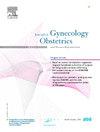在美国,体重指数类别中妊娠期体重增加过多与剖宫产的高风险相关。
IF 1.6
4区 医学
Q3 OBSTETRICS & GYNECOLOGY
Journal of gynecology obstetrics and human reproduction
Pub Date : 2025-08-10
DOI:10.1016/j.jogoh.2025.103010
引用次数: 0
摘要
目的:本研究探讨妊娠期体重增加率(GWG;“低于推荐率”、“在推荐率之内”和“超过推荐率”)以及在一系列身体质量指数(BMI)类别(体重不足、正常、超重、I、II和III级肥胖)中女性剖宫产的风险增加。研究设计:我们使用来自国家卫生统计中心的重要记录数据,包括2014年至2022年在美国分娩的无产、单胎足月分娩的头位胎儿(n=7,891,653)。我们使用多变量线性概率(分类GWG)和广义加性(连续GWG)模型评估GWG与分娩方式(剖宫产与阴道分娩)的关系。结果:约26%的新生儿为剖宫产,65%超过推荐的GWG率。剖宫产的风险随着BMI的增加而增加,孕前BMI高于正常值者剖宫产的风险更高。对于所有女性来说,过量的GWG (EGWG)增加了剖宫产的风险,但对孕前BMI较高的女性影响更为明显。在体重指数过轻或正常的女性中,GWG与剖宫产风险呈j型关系,而孕前体重指数被归类为超重或肥胖的女性,其GWG与剖宫产风险呈相对线性增加。结论:研究结果为不同BMI类别女性的EGWG和剖宫产风险增加提供了有价值的见解。在患者和提供者层面都需要做出额外的努力,以减少EGWG和剖宫产的风险。本文章由计算机程序翻译,如有差异,请以英文原文为准。
Excessive gestational weight gain associated with higher risk of cesarean delivery across body mass index categories in the United States
Objectives
This research investigated associations between rate of gestational weight gain (GWG; “below recommended rate,” “within recommended rate,” and “exceeding recommended rate”) and increased risk of cesarean delivery for women across a range of body mass index (BMI) categories (underweight, normal, overweight, obesity classes I, II, and III).
Study Design
We used vital records data from the National Center for Health Statistics to include nulliparous, singleton term births with cephalic presentation (n=7,891,653) to women who gave birth in the United States from 2014 through 2022. We evaluated the association of GWG on mode of birth (cesarean vs. vaginal delivery) using multivariable linear probability (categorical GWG) and generalized additive (continuous GWG) models.
Results
Approximately 26% of births were by cesarean delivery and 65% exceeded the recommended rate of GWG. Risk of cesarean delivery increased as BMI increased, and those in pre-pregnancy BMI above normal categories had higher risk of cesarean delivery. Excessive GWG (EGWG) increased the risk of cesarean delivery for all women, but the effect was more pronounced in those with a higher pre-pregnancy BMI. Among women whose BMI was underweight or normal, GWG had a J-shaped relationship with cesarean delivery risk, while women whose pre-pregnancy BMI was categorized as overweight or obese demonstrated a relatively linear increase in risk with any GWG.
Conclusions
Findings provide valuable insights on EGWG and increased risk of cesarean delivery for women across BMI categories. Additional efforts are needed at both the patient and provider level to reduce EGWG and the risk of cesarean delivery.
求助全文
通过发布文献求助,成功后即可免费获取论文全文。
去求助
来源期刊

Journal of gynecology obstetrics and human reproduction
Medicine-Obstetrics and Gynecology
CiteScore
3.70
自引率
5.30%
发文量
210
审稿时长
31 days
期刊介绍:
Formerly known as Journal de Gynécologie Obstétrique et Biologie de la Reproduction, Journal of Gynecology Obstetrics and Human Reproduction is the official Academic publication of the French College of Obstetricians and Gynecologists (Collège National des Gynécologues et Obstétriciens Français / CNGOF).
J Gynecol Obstet Hum Reprod publishes monthly, in English, research papers and techniques in the fields of Gynecology, Obstetrics, Neonatology and Human Reproduction: (guest) editorials, original articles, reviews, updates, technical notes, case reports, letters to the editor and guidelines.
Original works include clinical or laboratory investigations and clinical or equipment reports. Reviews include narrative reviews, systematic reviews and meta-analyses.
 求助内容:
求助内容: 应助结果提醒方式:
应助结果提醒方式:


